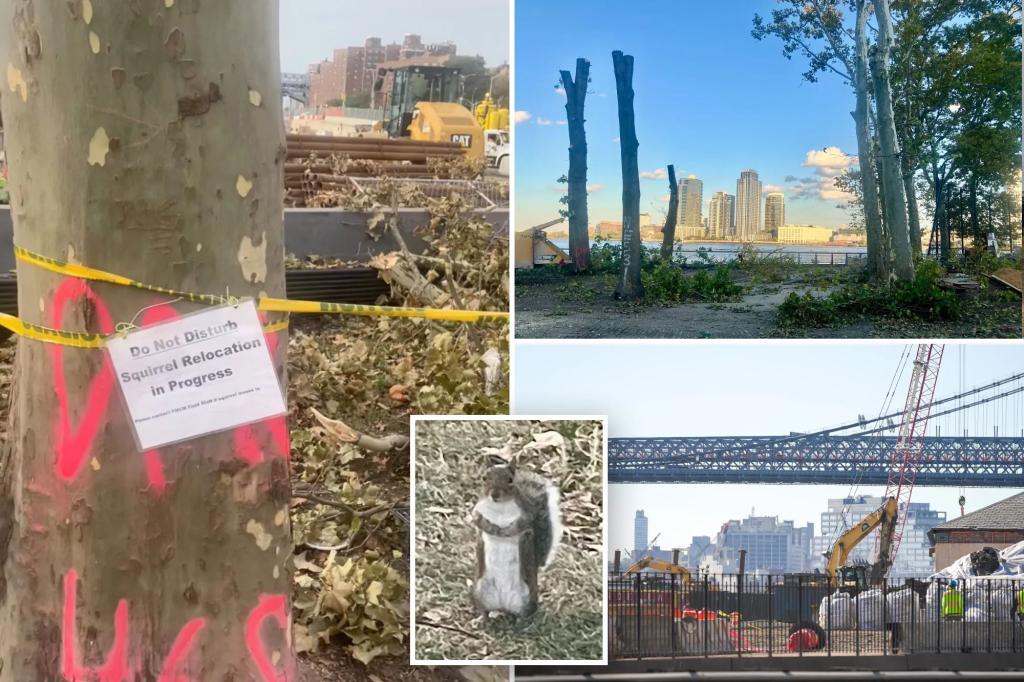City living sure can be nuts.
Dozens of Manhattan squirrels were forced to run for their lives and left “starving to death” when the city chopped down trees at an East Village park last month – and were only rescued after locals sounded alarms over the forgotten animals.
The squirrels’ longtime tree habitats at John V. Lindsay East River Park were razed in September as part of the ongoing shoreline resiliency project, leaving the critters trapped inside a concrete construction site without food, water or shelter – right in view of predatory hawks, fuming activists told The Post.
“It’s certain death” for the creatures without city intervention, said Michelle Ashkin, founder and president of Voices for Urban Wildlife, who helped to organize a meeting with upset locals, activists and the mayor’s office on Monday.
“They’ll die of starvation, stress, heat exhaustion: there’s no food, water, shelter or place to hide,” she added. “They’re New Yorkers and people love them: Nobody wants to see wildlife suffer through starvation, human negligence or lack of appropriate planning.”
A spokesperson for the city’s Department of Design and Construction, confirmed that, as a result of the ruckus, a licensed animal management company has humanely trapped over a dozen squirrels at the site since Tuesday.
The traps will remain in place until the remaining squirrels are captured or “disperse,” according to the department. The squirrels — 14 of which have been captured so far — will be transferred to a wildlife rehabilitator at the Wildlife Freedom Foundation.
“DDC is rebuilding East River Park at a higher elevation as part of the flood protection being provided by the $1.45 billion East Side Coastal Resiliency project,” the city rep said, “which will protect over 100,000 New Yorkers from sea level rise and coastal flooding.”
More than 1,800 new trees will also be planted in the new East River Park and more than 1,000 will be planted in surrounding communities upon the project’s completion, the rep added.
Ashkin called the resolution to the week-long dispute the “best case scenario” for the animals – but feared it only happened due to the public outcry, which also included the Urban Wildlife Alliance.
Longtime East Village resident Anthony Donovan said he filed a pair of 311 complaints last month regarding squirrels at the site — which were both quickly closed without action, according to a Post review of public records. Calls were also made to Parks and the NYPD about the alleged “animal abuse” taking place.
“They removed the only refuge that these squirrels had left. That to me is the crime,” Donovan, a 73-year-old hospice nurse, said.
“For these squirrels, this has been Gaza: there’s been piles of concrete, they’ve been going from home to home, moving from tree to tree up north, and now they’re surrounded in this little area.”
Other New Yorkers appeared to be similarly disturbed by the squirrels’ plight.
“They should at least take the precautions to safeguard the animals that are there, whether it’s the squirrels or chipmunks or the ducks that you occasionally see in the East River,” said Adrian Betancourt, a 60-year-old Lower East Side resident.
“I don’t appreciate them messing with the squirrel’s home, and they could probably go around it,” said 28-year-old Gregory Venable, also of the Lower East Side, “or they could improve the environment for them instead of them just trying to do things to do it.”
“I do wonder where the squirrels are going to live and why they’re doing this to their environment,” said Marianni Cuello Batista, 14. “A precaution could be just to leave the trees alone and just let them be there. I don’t know why they have to chop down.”
Activists say the conundrum underscores the larger issue of city officials overlooking impacts to animals during large construction projects.
Ashkin noted the environmental impact statement drafted – which is supposed to point out a project’s significant impacts to wildlife – lacked any plan to save the squirrels.
Wildlife observed in the study area consisted mostly of common or “disturbance-tolerant” species, according to the impact statement – though Ashkin argued the squirrels can’t escape the park’s barriers, flee to the East River or survive at the barren site.
“You need to have an environmental impact statement that includes something about wildlife,” Ashkin said. “There was either an unintended consequence, an unanticipated consequence or they didn’t involve the right experts … [the squirrels] were supposed to have some sort of egress to navigate out of the construction site.”
She hopes this will be a lesson for future city projects that affect New York’s urban wildlife, as now the squirrels are frightened due to the lack of trees and therefore may be harder to catch.
“We must include the safety of urban wildlife in our projects moving forward, and it has to be accurate and specific to the site,” she added.
“Wildlife is not collateral damage.”
Read the full article here

